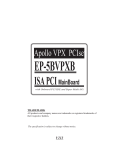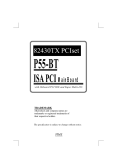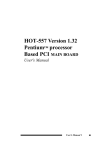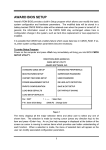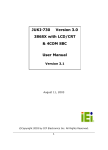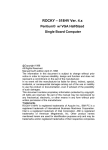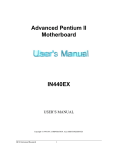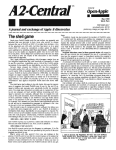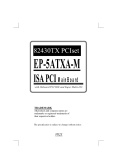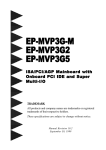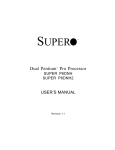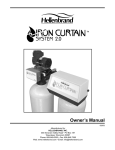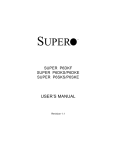Download P55-TV Layout
Transcript
82430VX PCIset P55-TV ISA PCI M o th e rB o a rd with Onboard PCI IDE and Super Multi-I/O. TRADEMARK All products and company names are trademarks or registered trademarks of their respective holders. The specification is subject to change without notice. Contents page Chapter 1 - Introduction..................................................1-1 P55-TV Board Layout............................................................1-2 Chapter 2 - Hardware Design ......................................... 2-1 2-1 2-2 2-3 2-4 2-5 Motherboard Layout .....................................................2-1 Connectors and Jumpers ...............................................2-2 System Memory configuration ......................................2-4 Cache Memory configuration .......................................2-6 Integrated PCI Bridge ..................................................2-8 Chapter 3 - Award BIOS SETUP ................................... 3-1 3-1 Standard CMOS Setup .................................................3-2 3-3 BIOS Features Setup ....................................................3-2 3-3 Chipset Features Setup .................................................3-6 3-4 Power Management Setup ............................................3-8 3-5 PNP/PCI Configuration ................................................3-10 3-6 Integated Peripherals..................................................... 3-12 3-7 Load Setup Defaults .....................................................3-14 3-8 Change Supervisor or User password ...........................3-15 3-9 IDE HDD Auto Detection .............................................3-16 3-10 HDD Low Level Format............................................... 3-18 3-11 Save & Exit Setup ....................................................... 3-18 3-11 Exit Without Saving .....................................................3-18 Chapter 4 - Onboard Technical Information...................4-1 4-1 I/O & Memory Map .................................................... 4-1 4-2 Time & DMA Channels Map ...................................... 4-2 4-3 Interrupt Map ............................................................. 4-2 4-4 RTC & CMOS RAM Map ........................................... 4-3 Appendix A: Post Codes .................................................... 4-4 Appendix B: I/O Connector .............................................. 4-8 Appendix C: Memory Configuration Table....................... 4-11 NOTE : The "LOAD SETUP DEFAULTS" function loads the system default data directly from ROM and initialize associated hardware properly. This function will be necessary when you accept this motherboard, or the system CMOS data is corrupted. ROM PCI/ISA BIOS CMOS SETUP UTILITY AWARD SOFTWARE, INC. STANDARD CMOS SETUP SUPERVISOR PASSWORD BIOS FEATURES SETUP USER PASSWORD CHIPSET FEATURES SETUP IDE HDD AUTO DETECTION POWER MANAGEMENT SETUP HDD LOW LEVEL FORMAT PNP/PCI CONFIGURA Load SETUP Default (Y/N)? Y INTEGRATED PERIPH ETUP SAVING LOAD SETUP DEFAULTS ESC: QUIT F10:Save & Exit Setup :SELECT ITEM (Shift)F2 :Change Color Load Setup Defaults Except Standard COMS SETUP LOAD SETUP DEFAULT Introduction 1-1 Chapter 1 Introduction The P55-TV motherboard is a high performance system hardware based on Intel PentiumR processor and is equipped with four PCI slots, four standard ISA slots, Super Multi-I/O controller and dual ports PCI-IDE connectors for the future expansion. The hardware dimension is 220mm x 280mm with four layer design technology. Specification Intel 82430VX PCIset chipset. R Intel Pentium Processor operating at 75 ~ 200 MHz and P55C with 321 ZIF socket 7 provides scalability to accept faster Processors in the future. Supports up to 128 MegaBytes DRAM(minimum of 8 MB) on board(72 Pins SIMM x 4, 168 Pins DIMM x 1), and BIOS auto FP DRAM, EDO DRAM and SDRAM configuration.(Refer to Chapter 2-3 System Memory Configuration) Supports Onboard Burst/Pipelined burst synchronous (the COAST 2.1 solusion) L2 Write Back Cache. The cache memory combination could be 256KB/512KB (32KB*32 or 64KB*32 SRAM respectively). Support four 16 bits ISA slots, four 32 bits PCI slots, and provides two independent high performance PCI IDE interface capable of supporting PIO Mode 3 and Mode 4 devices. The P55-TV supports four PCI Bus Masters and a jumperless PCI INT# control scheme which reduces configuration confusion when plug in PCI I/O controller card(s). Supports AT API (e.g. CD-ROM) devices on both IDE interface. Supports 1 floppy port, 1 parallel port (EPP,ECP port), and 2 serial port (16550 Fast UART compatible). Supports a PS/2 style mouse and standard AT style keyboard connectors. Supports Award Plug & Play BIOS . The BIOS is stored in Flash EPROM form. It provides better upgradeability for the system. Supports CPU Hardware sleep and SMM (System Management Mode). P55-TV utilizes Lithium battery which provides environmental protection and longer life time. 1-2 P55-TV P55-TV Layout 1 JP2 1 J1 CN1 < < J2 JP18 1 Socket 7 3 < 1 JP16 JP15 U25 82438VX U28 32K*32 KEYLOCK 5 1 SPEAKER RESET TB-LED HD-LED G-LED SLEEP + + + 3 1 JP19 JP20 160 Figure 1-1 80 BANK1 U24 82438 JP14 BANK0 BANK0 SRAM Module GND COM1 82437VX COM2 TAG SRAM (U17) RTC BIOS Intel +12V 1 K/B CONN. DIMM SIMM 4 SIMM 3 SIMM 2 SIMM 1 1 Primary IDE Secondary IDE JP4 JP5 JP6 81 GND 5 PRINTER FDD CONN. PCI#1 PCI#2 PCI#3 PCI#4 82371SB 1 JP7 J10 Power Conn. Intel JP8 USB Conn. W83877F Keyboard BIOS < 82438VX U27 32K*32 Hardware Design 2-1 Chapter 2 Hardware design 2-1 Motherboard Layout The P55-TV is designed with Intel 82430VX PCIset chipset which is developed by INTEL Corporation to fully support Pentium Processor PCI/ISA system. The Intel 82430VX PCIset chipset prpovides increased integration and improved performance designs. The chipset provides an integrated IDE controller with two high performance IDE interfaces for up to four IDE devices (hard devices, CDROM device, etc). The Winbond W83877F Super I/O controller provides the standard PC I/O function: floppy interface, two 16 Byte FIFO serial ports and EPP/ ECP capable parallel port. The P55-TV layout is shown in previous page (left page) for user's reference. Care must be taken when inserting memory modules, inserting CPU or even plugging PCI card into associated slots to avoid damaging any circuits or sockets on board. A cooling fan is strongly recommended when installing P54C/P54CTB/P55C/K5/6x86 processor due to possible overheat. The P55-TV supports minimum of 8MB of System Memory and maximum of 128MB while L2 Cache can be 256KB/512KB synchronous SRAM Onboard with the COAST 2.1 "Cache-On-A-STick" solution to increase system performance.( refer to Page 2-5 Cache Memory Configuration for the details.) The P55-TV supports standard Fast Page, EDO (Extended Data Out or Hyper Page Mode) or synchronous DRAM. The P55-TV provides four 72-pins SIMM and one 168-pins DIMM sites for memory expansion. The socket support 1M x 32(4MB), 2M x 32(8MB), 4M x 32(16MB), and 8M x 32(32MB) single-sided or double-sided memory modules. The memory timing requires 70 nS Fast page devices or 60 nS EDO DRAM. Memory parity generation and checking is not supported. (DRAM Modules may be parity[x 36] or non-parity[x 32]. The P55-TV supports Onboard two PCI IDE connectors, and detects IDE harddisk type by BIOS utility automatic. The P55-TV supports Award Plug & Play BIOS for the ISA and PCI cards. The BIOS can be located in Flash EPROM. The advantage of having Flash EPROM is much easier to replace BIOS code if necessary. 2-2 P55-TV 2-2 Connectors and Jumpers This section describes all of the connectors and jumpers equipped in the motherboard. Please refer to Figure 1-1 for actual location of each connector and jumper. 5 1 KeyLock - Keyboard lock switch & Power LED connector. 1.Power LED(+) 2.N/C 3.GND 4.Keylock 5.GND Speaker - connect to the system's speaker for beeping. 7. Speaker 8. N/C 9. GND 10. GND Reset - Close to restart system. + Turbo LED indicator - LED ON when higher speed is selected. + Power Saving LED indicator - LED ON when system is in any Saving mode. + Harddisk LED indicator - LED ON when Onboard PCI IDE Harddisks activites. Sleep/Resume switch : Close to enter sleep mode. A keystrobe or mouse movement (mouse driver exists). The system will instantly "wake up". 1 3 J2 The Power Supply (+12V) of the CPU Cooling FAN: 1.GND 2.+12V 3.GND Hardware Design 1 JP2 Keyboard Clock Select : 1-2 : The Clock rate equal to the system ISA CLOCK. 2-3 : The Clock rate equal to 12MHz. 3 1 JP7 BIOS Operation Mode : 1-2 : Normal Operating. 2-3 : Bootblock Flash Mode. 3 JP8 EPROM BIOS Select : 1-2 : 5V Flash EPROM.(SST, Winbond). 2-3 : 12V Flash EPROM (Intel). 1 3 1 JP14 2-3 CPU Vcore voltage select : 1-2 : 2.5V 2-3 : 2.8V (Default) Open : 2.9V 3 Note : JP14 is reserved for Pentium MMX, Cyrix 6x86L and AMD K6 only. For other CPU it must be ignored. JP18 CPU Install : 1-2 : Intel Pentium, Cyrix 6x86 and AMD K5. 2-3 : Intel Pentium MMX, Cyrix 6x86L and AMD K6. 1 J1 3 IrDA/ASK IR CONNECTOR: 1 5 J10 1 5 1.VCC 2.NC 3.IRRX 4.GND 5.IRTX PS/2 MOUSE CONNECTOR: 1.RED wire 2.BLUE wire 3.GREEN wire 4.NC 5.YELLOW wire 2-4 P55-TV R Intel Pentium Processor / AMD K5 Installation Clock/CPU Op. JP4 JP5 JP6 50/75 MHz 60/90 MHz CLOSE CLOSE OPEN CLOSE OPEN OPEN 66/100 MHz OPEN OPEN OPEN JP4 60/120 MHz CLOSE OPEN OPEN JP5 JP19 66/133 MHz 60/150 MHz 66/166 MHz 60/180 MHz OPEN CLOSE OPEN CLOSE OPEN OPEN OPEN OPEN OPEN OPEN OPEN OPEN JP20 66/200 MHz OPEN OPEN OPEN JP6 1 2 3 JP19 JP20 1-2 1-2 1-2 2-3 2-3 2-3 2-3 1-2 * Clock is System Clock. * CPU OP. : CPU operation at 75, 90, 100 MHz, and etc. Cyrix 6x86 / 6x86L Installation CPU TYPE (Reserved) JP4 JP5 JP6 6x86-P120+ CLOSE CLOSE OPEN 6x86-P133+ OPEN 6x86-P150+ CLOSE OPEN OPEN 6x86-P166+ OPEN OPEN OPEN 6x86-P200+ OPEN OPEN CLOSE JP19 JP20 1-2 2-3 CLOSE OPEN * 6x86-P120+ = 50/100MHz, 6x86-P133+ = 55/110MHz * 6x86-P150+ = 60/120MHz, 6x86-P166+ = 66/133MHz * 6x86-P200+ = 75/150MHz Note 1 : If the Cyrix M1(6x86) is installed on the P55-TV motherboard, one of the two types of cooling fan(Model NO. 20750 is normal /standard fan/heatsink. Model NO. 20832 is 90 degree rotated fan.) must be selected correctly to match the regulator heatsink direction. The P55-TV reguires the use of Model NO : 20832.(Customer should reguest NMB-B50 fan). Please Contact the Cyrix CPU suppliers for the details. Note 2 : If the Cyrix 6x86-P200+ is installed on the P55-TV motherboard, there is a limitation : It cannot work properly with the PCI 2.0 SCSI card.(For example : Adaptec AHA-2940/3940). It will make your system hang or damage the data in the harddisk. Please do not install 6x86-P200+ with PCI 2.0 SCSI card on P55TV motherboard. But, You can choose PCI 2.1 SCSI card(For example : AHA-2940AU/ 2940UW). They do not have above problem. Hardware Design 2-5 2-3 System Memory Configuration The P55-TV supports different type of settings for the system memory. Following figures provides all possible memory combinations. Please refer to Appendix C: Memory Configuration Table for the details. DIMM M4 M3 M2 M1 M1,M2 (BANK 0) M3,M4 (BANK 1) > > > BANK 0 3V Synchronous DRAM or 3V FP / EDO DRAM BANK 1 5V FP / EDO DRAM BANK 0 5V FP / EDO DRAM DIMM (BANK 0) STATUS OK OK OK OK OK Installed None None Installed None * Installed None Installed None Installed Installed None None None Installed None Installed Installed * Installed Installed Installed Not Allowed Note 2 Not Allowed Note 2 NOTE : 1. P55-TV supports both Fast Page DRAM and EDO DRAM SIMMs, but they can not be mixed in the same memory bank. * 2. Because the DIMM or (M1+M2) occupies the same memory block (BANK 0). So they cannot be installed at the same time. 3. DIMM Module Specification : 3.3V / Unbuffered LEFT KEY ZONE (UNBUFFERED) CENTER KEY ZONE (3.3 V DRAM) The P55-TV supports 168-pin DIMM module to extend system memory size.You can install (3.3V / UNBUFFERED) Fast Page, EDO or Synchronous DRAM. When you have a DIMM module to plug into a 168-pin dual readout connnector, you R must make sure that the DIMM module is 3.3V/Unbuffered and supports Intel Pentium Processor System. 2-6 P55-TV 2-4 Cache Memory Configuration The second level (L2) of cache is installed in the motherboard to increase the system performance. The P55-TV supports different type of combinations for the cache installation. The COAST 2.1 (Cache-On-A-STick. The cache modules has a TAG SRAM.) solution provides Onboard flexibility, allowing Onboard and modules to accommodate 256KB/512KB burst and piplined burst synchronous SRAM. Jumper JP15 and JP16 are used to set onboard synchronous SRAM for differential such combinations. Please refer to following configurations for the details. 32K*32 32K*32 U41 U28 U37 U18 TAG SRAM U27 U34 U28 JP15 JP16 U29 U32 1 DATA SRAM SYN.CACHE Size On Board (U27,U28) On Module (SM1) Jumper Setting JP15 JP16 256KB 256KB None 1-2 1-2 256KB None 256KB 2-3 1-2 512KB 256KB 256KB 1-2 1-2 512KB 512KB None 1-2 2-3 512KB None 512KB 2-3 1-2 KEY 160 81 v SM1 80 Burst/Pipelined burst/Asynchronous SRAM Modules TAG SRAM 32K*32 Figure 2-1 COAST MODULE 32K*32 1 Hardware Design 2-7 The P55-TV may have come with an optinal COAST Module (Ref. Figure 2-1)to extend the onboard cache size from 256KB to 512KB (When the P55-TV had mounted 256 KB (32K*32 x 2 synchronous SRAM). Note 1: When you have a cache module to plug into a 160-pin daul readout connector. You must make sure that the cache module follow the speciification of Intel COAST 2.0 or later version. Please contact the modules supplier to avoid not working properly or damaging any modules circuits. Note 2 : Please be noted that some Synchronous SRAM can not support theTWO BANK L2 CACHE. For example, the SEC KM732V588G SRAM from SAMSUNG will not be able to support the TWO BANK function. 2-8 P55-TV 2-5 Integrated PCI Bridge The P55-TV utilizes Intel's 430VX PCIset chipset to support Intel Pentium Processor PCI/ISA system. The Intel 82430VX PCIset chipset consists of the 82437VX system controller (TSC), two 82438VX Data Path (TDP) devices, and one 82371SB PCI ISA/IDE Accelerator (PIIX3) bridge chip. It provides an interface which translates CPU cycle into PCI bus cycle, and PCI burst read/write capability. In addition, it provides high performance PCI arbitor to support four PCI Masters, Rotating Priority Mechanism, and Hidden Arbitration Scheme Minimizes Arbitration Overhead. There are four interrupts in each PCI slot : INTA#, INTB#, INTC#, and INTD#. Since the P55-TV adapts the PCI auto-configuration with the system BIOS Setup utility. When the system is turned on after adding a PCI add-in card, the BIOS automatically configure interrupts, DMA channels, I/O space, and other paramaters. You do not have to configure jumpers or worry potential resource conflicts. Because PCI cards use the same interrupt resource as ISA cards, you must specify the interrupt used by ISA add-in cards in the BIOS Setup utility. If however, a "Legacy card" (such as plug paddle card and cable into the ISA slot.) is plugged in the system, modification in the ROM SETUP UTILITY become necessary. First, enter PCI CONFIGURATION SETUP utility from ROM SETUP UTILITY main menu to set the "PCI IDE IRQ MAP TO : ISA". Secondly, you must enter CHIPSET FEATURES SETUP UTILITY from ROM SETUP UTILITY main menu and set the " Onboard Primary PCI IDE: Disabled and Onboard Secondary PCI IDE: Disabled." When you plugg the PCI/ISA IDE card into the system, You should Disabled Onboard Primary and Secondary PCI IDE from CHIPSET FEATURES SETUP UTILITY too. Some "Legacy card" ( no paddle card and cable.) you can set the system interrupt request (IRQ) on the "Legacy card" (refer to user's manual of the card) to a proper system IRQ level (in general, card's Primary assigned to INTA and Secondary assigned to INTB). If the card is plugged into slot 1(marked PCI#1), you can not use second slot (marked PCI#2) because the Secondary INT signal takes INTB from the slot (refer to Page 3-12 for circuit diagram). The user then enter PCI CONFIGURATION SETUP utility from ROM SETUP UTILITY main menu and set the "PCI IDE IRQ MAP TO : PCI-Slot 1" (depend on the slot # where the Legacy card is plugged). . AWARD BIOS 3-1 Chapter 3 AWARD BIOS Setup Award's ROM BIOS provides a built-in Setup program which allows user to modify the basic system configuration and hardware parameters. The modified data will be stored in a battery-backed CMOS RAM so data will be retained even when the power is turned off. In general, the information saved in the CMOS RAM stay unchanged unless there is a configuration change in the system, such as a hard drive replacement or a new device installment. It is possible for the CMOS battery to fail. This will cause data lose in CMOS only.If this does happen you will need to reconfigure your configuration parameters. To enter Setup Propgram Power on the computer and press <Del> key immediately . This will bring you into BIOS CMOS SETUP UTILITY. ROM PCI/ISA BIOS(2A59GPAC) CMOS SETUP UTILITY AWARD SOFTWARE, INC. STANDARD CMOS SETUP SUPERVISOR PASSWORD BIOS FEATURES SETUP USER PASSWORD CHIPSET FEATURES SETUP IDE HDD AUTO DETECTION POWER MANAGEMENT SETUP HDD LOW LEVEL FORMAT PNP/PCI CONFIGURATION SAVE & EXIT SETUP INTEGRATED PERIPHERALS EXIT WITHOUT SAVING LOAD SETUP DEFAULTS ESC : QUIT : SELECT ITEM F10 : Save & Exit Setup (Shift)F2 : Change Color Time, Date, Hard Disk Type... Figure 3-1 CMOS SETUP UTILITY The menu displays all the major selection items. Select the item you need to reconfigure. The selection is made by moving cursor (press any direction key ) to the item and press the 'Enter' key. An on-line help message is displayed at the bottom of the screen as the cursor is moving to various items which provides a better understanding of each function. When a selection is made, the menu of selected item will appear so the user can modify associated configuration parameters. 3-2 CHAPTER 3 3-1 STANDARD CMOS SETUP Choose "STANDARD CMOS SETUP" in the CMOS SETUP UTILITYMenu (Fig.31). The STANDARD CMOS SETUPallows user to configure system setting such as the current date and time, type of hard disk drive installed, floppy drive type, and display type. Memory size is auto-detected by the BIOS and displayed for your reference. When a field is highlighted (use direction keys to move cursor and <Enter> key to select), the entry in the field will be changed by pressing <PgDn> or <PgUp> keys or user can enter new data directly from the keyboard. ROM PCI/ISA BIOS(2A59GPAC) STANDARD CMOS SETUP AWARD SOFTWARE, INC. Date (mm:dd:yy) : Wed, Apr 17 1996 Time (hh:mm:ss) : 14 : 30 : 50 HARD DISKS TYPE Primary Master :Auto Primary Slave :Auto Secondary Master : Auto Secondary Slave :Auto SIZE 0 0 0 0 CYLS 0 0 0 0 HEAD 0 0 0 0 Drive A : 1.44M, 3.5 in. Drive B : None Floppy 3 Mode Support : Disabled Video : EGA/VGA Halt On : All Errors PRECOMP 0 0 0 0 LANDZONE 0 0 0 0 Base Memory : Extended Memory : Other Memory : SECTORS MODE 0 Auto 0 Auto 0 Auto 0 Auto 640K 31744K 384K Total Memory : 32768K ESC : Quit F1 : Help (Shift) F2 : Select Item : Change Color PU/PD/+/- : Modify Figure 3-2 STANDARD CMOS SETUP NOTE: If hard disk Primary Master/Slave and Secondary Master/Slave use Auto, then the hard disk size and model will be auto-detected. NOTE: The "Halt On :" field is to determine when to halt the system by the BIOS if an error occurrs. 3-2 BIOS FEATURES SETUP Selecting the "BIOS FEATURES SETUP" option in theCMOS SETUP UTILITYmenu allows user to change system related parameters in the displayed menu. This menu shows all of the manufacturer's default values of the P55TV2. Again, user can move the cursor by pressing direction keys and <PgDn> or <PgUp> keys to modify the parameters. Pressing [F1] key to display help message of the selected item. This setup program also provides 2 convenient ways to load the default parameter data from BIOS [F6] or CMOS [F7] area if the shown data is corrupted. This provides the system a capability to recover from any possible error. AWARD BIOS 3-3 ROM PCI/ISA BIOS(2A59GPAC) BIOS FEATURES SETUP AWARD SOFTWARE, INC. Virus Warning CPU Internal Cache External Cache Quick Power On Self Test Boot Sequence Swap Floppy Drive Boot Up Floppy Seek Boot Up NumLock Status Boot UP System Speed Gate A20 option Typematic Rate Setting Typematic Rate (Chars/Sec) Type matic Delay (Msec) Security Option PCI/VGA Palette Snoop OS Select For DRAM > 64MB : : : : : : : : : : : : Disabled Enabled Enabled Enabled A,C, SCSI Disabled Enabled On High Fast Disabled 6 : 250 : Setup : Disabled : Non-OS2 Video BIOS C8000-CBFFF CC000-CFFFF D0000-D3FFF D4000-D7FFF D8000-DBFFF DC000-DFFFF Shadow Shadow Shadow Shadow Shadow Shadow Shadow Esc : Quit F1 : Help F5 : Old Values F7 : Load Setup Defaults : : : : : : : Enabled Disabled Disabled Disabled Disabled Disabled Disabled : Select Item PU/PD/+/- : Modify (Shift)F2 : Color Figure 3-3 BIOS FEATURES SETUP Note: The Security Option contians "setup" and "system". The "setup" indicates that the password setting is for CMOS only while the "system" indicates the password setting is for both CMOS and system boot up. Virus Warning: This category flashes on the screen. During and after the system boots up, any attempts to write to the boot sector or partition table of the hard disk drive will halt the system and an error message will appear. You should then run an anti-virus program to locate the virus. Keep in mind that this feature protects only the boot sector, not the entire hard drive. Default value is Disabled Enabled : Activate automatically when the system boots up causing a warning message to appear when any attempts to access the boot sector or the hard disk partition table. Disabled: No warning message to appear when any attempts to access the boot sector or the hard disk partition table. CPU Internal Cache / External Cache: These two categories speed up memory access. However, it depends on CPU/chipset design. The default value is Enabled. If your CPU is without Internal Cache then the item "CPU Internal Cache" will not show. Enabled: Enable cache. Disable : Disable cache. 3-4 CHAPTER 3 Quick Power On Self Test:This category speeds up Power On Self Test (POST) after you power on the computer. If it is set to Enable, BIOS will shorten or skip some check items during POST. Enabled : Enable quick POST. Disabled: Normal POST. Boot Sequence:This category determines which drive is searched for first for the O/S(Operating System). Default value is A,C. A,C : System will first search for the floppy disk drive then the hard disk drive. C,A : System will first search for the hard disk drive then the floppy disk drive. CDROM,C,A: System will first search for the CDROM drive (If the CDROM has a bootable CD title.) and second search for the hard disk drive then the flopp disk drive. C,CDROM,A: System will first search for the hard disk driver and second search for the CDROM drive (If the CDROM has a bootable CD title.) then the floppy disk drive. Swap Floppy Drive: This will swap your physical drive letters A&B if you are using two floppy disks. Default value is Disabled. Enabled : Floppy A & B will be swapped under the O/S. Disabled: Floppy A & B will be not swapped. Boot Up Floppy Seek: During POST,BIOS will determine if the floppy disk drive installed is 40 or 80 tracks. Only 360K type is 40 tracks while 760K, 1.2M and 1.44M are all 80 tracks. The default value is Enabled. Enabled : BIOS searches for the floppy disk drive to determine if it is 40 or 80 tracks. Note that BIOS cannot tell from 720K, 1.2M or 1.44M drive type as they are all 80 tracks. Disabled: BIOS will not search for the type of floppy disk drive by track number. Note that there will not be any warning message if the drive installed is 360K. Boot Up NumLock Status: The default value is On. On : Keypad is number keys. Off : Keypad is arrow keys. Boot UP System Speed: Select the default system speed. The system will run at the selected speed after the system boots. High: Set the speed to high. Low : Set the speed to low. Gate A20 Option : This refers to the way the system addresses memory above 1MB (extended memory). The default value is Fast. Normal : The A20 signal is controlled by keyboard controller or chipset hardware. Fast : The A20 signal is controlled by Port 92 or chipset specific method. AWARD BIOS 3-5 Typematic Rate Setting : This determines the typematic rate. Enabled : Enable typematic rate and typematic delay programming. Disabled: Disable typematic rate and typematic delay programming. The system BIOS will use default value of these 2 items and the default is controlled by keyboard. Typematic Rate(Chars/Sec): 6 : 6 characters per second. 10: 10 characters per second. 15: 15 characters per second. 24: 24 characters per second. 8 : 8 characters per second. 12: 12 characters per second. 20: 20 characters per second. 30: 30 characters per second. Typematic Delay(Msec): When holding a key, the time between the first and second character displayed is typematic delay. 250 : 250msec. 500 : 500 msec. 750 : 750 msec. 1000: 1000 msec. Security Option: This category allows you to limit access to the system and Setup, or just to Setup. The default value is Setup. System: The system will not boot and access to Setup if the correct password is not entered at the prompt. Setup : The system will boot, but the access to Setup will be denied if the correct password is not entered at the prompt. PCI/VGA Palette Snoop: This filed controls the ability of a primary PCI VGA controller to share a common palette (when a snoop write cycles) with an ISA video card. The default value is Disabled. Enabled: If an ISA card connects to a PCI VGA card via the VESA connector and the ISA card connects to VGA monitor and that ISA card uses the RAMDAC of PCI card, the PCI/VGA Palette Snoop is enabled. Disabled: Disable the VGA card Palette snoop function. Video BIOS Shadow: It determines whether video BIOS will be copied to RAM, however, it is optional from chipset design. Video Shadow will increase the video speed. Enabled : Video shadow is enabled. Disabled: Video shadow is disabled. 3-6 CHAPTER 3 C8000 CC000 D0000 D4000 D8000 DC000 - CBFFF CFFFF D3FFF D7FFF DBFFF DFFFF Shadow : Shadow: Shadow: Shadow: Shadow: Shadow: These categories determine whether other expansion card optional ROM will be copied to RAM by 16K byte or 32K byte perunit and the size depends on chipset. If you install other expansion cards with ROMs on them, you will need know which addresses the ROMs used to shadow themselves specifically. Enabled : Optional shadow is enabled. Disabled: Optional shadow is disabled. 3-3 CHIPSET FEATURES SETUP Choose the "CHIPSET FEATURES SETUP" in the CMOS SETUP UTILITY menu to display the following menu. ROM PCI/ISA BIOS(2A59GPAC) CHIPSET FEATURES SETUP AWARD SOFTWARE, INC. Auto Configuration DRAM Timing : Enabled : 60 ns DRAM RAS# Precharge Time DRAM R/W Leadoff Timing Fast RAS to CAS Delay DAM Read Burst (EDO/FP) DRAM Write Burst Timing Fast MA to RAS# Delay CLK Fast EDO Path Select Refresh RAS# Assertion ISA Bus Clock Pipline Cache Timing :3 :6 :3 : x222/x333 : x222 :1 : Disabled : 4 Clks : PCICLK/4 : Fastest System BIOS Cacheable Video BIOS Cacheable 8 Bit I/O Recovery Time 16 Bit I/O Recovery Time Memory Hole At 15M-16M : : : : : Disabled Enabled 1 1 Disabled Peer Concurrency Chipset NA# Asserted Passive Release Delayed Transaction : : : : Enabled Enabled Enabled Disabled Esc : Quit : Select Item F1 : Help PU/PD/+/- : Modify F5 : Old Values (Shift)F2 : Color F7 : Load Setup Defaults Figure 3-4 CHIPSET FEATURES SETUP AWARD BIOS 3-7 Auto Configuration: This Category allows you to set the DRAM timing. The default value is Enabled. When disabled this field, you can select the different DRAM timings supported by chipsets. Note: When you insert slower memory modules in the system and set a faster timing, maybe, the system will hang up. DRAM Timing: The default value is 60ns. 60ns : 2 (faster) Burst Wait State, for 60~70ns Fast Page Mode/EDO DRAM. 70ns : 3 (slower) Burst Wait State, for 70ns Fast Page Mode/EDO DRAM. Video BIOS Cacheable: The default value is Enabled. Enabled : Enable the Video BIOS Cacheable to speed up the VGA Performance. Disabled: Disable the Video BIOS Cacheable function. 8/16 Bit I/O Recovery Time: The default value is 1. 8 Bit I/O Recovery Time: This field defines the recovery time from 1 to 8 for 8bit I/O. 16 Bit I/O Recovery Time: To define the recovery time from 1 to 4 for 16-bit I/O. Memory Hole at 15M-16M: The default value is Disabled. Disabled: Normal Setting. Enabled : enable the main memory (15~16MB) remap to ISA BUS. This feature reserves 15MB to 16MB memory address space to ISA expansion card that specifically requires this setting. Peer Concurrency: The default value is Enabled. Chipset NA# Asserted: The default value is Enabled. Passive Release: The default value is Enabled. Delay Transaction: The default value is Disabled. 3-4 POWER MANAGEMENT SETUP Choose the "POWER MANAGEMENT SETUP" in the CMOS SETUP UTILITY to display the following screen. This menu allows user to modify the power management parameters and IRQ signals. In general, these parameters should not be changed unless it is absolutely necessary. 3-8 CHAPTER 3 ROM PCI/ISA BIOS POWER MANAGEMENT SETUP AWARD SOFTWARE, INC. Power Management PM Control by APM Video off Method MODEM Use IRQ : User Define : Yes : V/H SYNC+Blank : 3 Doze Mode Standby Mode Suspend Mode HDD Power Down : Disable : Disabled : Disabled : 15 Min ** Wake Up Events In Doze & Standby ** IRQ3 (Wake-Up Event) : ON IRQ4 (Wake-Up Event) : ON IRQ8 (Wake-Up Event) : ON IRQ12 (Wake-Up Event) : ON ** Power Down & Resume Events IRQ3 (COM 2) IRQ4 (COM 1) IRQ5 (LPT 2) IRQ6 (Floppy Disk) IRQ7 (LPT 1) IRQ8 (RTC Alarm) IRQ9 (IRQ2 Redir) IRQ10 (Reserved) IRQ11 (Reserved) IRQ12 (PS/2 Mouse) IRQ13 (Coprocessor) IRQ14 (Hard Disk) IRQ15 (Reserved0 ** : ON : ON : ON : ON : OFF : OFF : ON : ON : ON : ON : ON : ON : ON Esc : Quit : Select Item F1 : Help PU/PD/+/- : Modify F5 : Old Values (Shift)F2: Color F7 : Load Setup Defaults Figure 3-5 POWER MANAGEMENT SETUP Again, user can move the cursor by pressing direction keys to the field that needs to be modified and press <PgDn> or <PgUp> to alter item selection. You can only change the content of Doze Mode, Standby Mode, and Suspend Mode when the Power Management is set to U ' ser Define'. Note: When the computer enters the suspend mode (setting the suspend mode valid range from 1 minute up to 1 hour) activated by the BIOS Power Management, you need to RUN a program POWER.EXE under DOS root, or need to add DEVICE=C:\DOS\POWER.EXE in your CONFIG.SYS. This will keep the system time updating normally when the system wake up from the suspend R mode. The supend mode for Windows 95 or windows 3.1x must have windows APM feature installed. Choose "Advanced Power Management" item from "system device". The "system device" field was from "system" icon in the "control panel." 3-4-1 The Description of the Power Management A. Power Management mode selection : Disabled : The system operates in NORMAL conditions (Non-GREEN) and the Power Management function is disabled. Max. saving: This mode will maximize the power saving capability. Min. saving: This mode will minimize the power saving capability. User Define: Allows user to define time-out parameters to control the power saving mode. Refer to item B shown below. AWARD BIOS 3-9 B. Time-out parameters : HDD Standby HDD Standby timer can be set from 1 to 15 minute(s). System Doze The "System Doze" mode timer starts to count when there is no "PM events" occurred. The valid time-out setting is from 1 minute up to 1 hour. System Standby The "Standby" mode timer starts to count when "System Doze" mode timer timed out and no "PM events" occurred. Valid range is from 1 minute up to 1 hour. System Suspend R This function works only when the Pentium Procssor is installed.The timer starts to count when "System Standby" mode timer is timed out and no "PM Events" occurred. Valid range is from 1 minute up to 1 hour. 3-4-2 Description of the Green Functions The P55TV2 supports HDD Power Down, Doze and standby power saving functions when Intel PentiumR Processor is installed. In addition, the suspend function is supported when the J2's sleep (refer to Figure1-1) is closed to enter the green function. The detailed descriptions of these functions are provided in the next page. HDD Power Down When system stop reading or writing HDD, the timer starts to count. The system will cut off the HDD power when timer runs out of time. The system will not resume operation until either a read from or a wirte to HDD command is executed again. Doze Mode The system hardware will drop down CPU clock from nomal working speed when Doze mode time-out occurs Standby Mode When the system standby mode timer times-out, it will enter the standby mode and retain CPU at slow working speed. The screen will be blanked out. Suspend Mode When the system suspend timer times-out, the system will enter the suspend mode and the chipset will stop CPU clock immediately. The power consumption in Suspend Mode is lower than in standby mode. The screen is also blanked out. 3-10 CHAPTER 3 PM Events: AWARD BIOS defines 15 PM Events in the power management mode (Doze, standby & suspend). The user can initialize any PM Events to be "Enable" or "Disable". When the system detects all of the enabled events, do not have any activity. It will start the system Doze timer first if the "Power Management" is not "Disabled". Once the system Doze timer is timed out, it will process doze power saving procedure by starting the system standby timer. When the standby timer run out and all of the "Enabled" events remains silent, the system will enter the standby mode. By now, the system will not only process the standby power saving procedures but also start the system suspend timer. When the suspend timer times out, all of the CPU clock will stop by dropping system clock down to zero and remains this way until any one of the "Enabled" event occurrs. 3-5 PnP/PCI CONFIGURATION The PnP/PCI configuration program is for the user to modify the PCI/ISA IRQ signals when various PCI/ISA cards are inserted in the PCI or ISA slots. WARNING : Conflicting IRQs may cause the system to not find cutain devices ROM PCI/ISA BIOS(2A59CPAC) PNP/PCICONFIGURATION AWARD SOFTWARE, INC. Resources Controlled By Reset Configuration Data : Manual : Disabled IRQ-3 IRQ-4 IRQ-5 IRQ-7 IRQ-9 IRQ-10 IRQ-11 IRQ-12 IRQ-14 IRQ-15 DMA-0 DMA-1 DMA-3 DMA-5 DMA-6 DMA-7 : Legacy ISA : Legacy ISA : PCI/ISA PnP :PCI/ISA PnP : PCI/ISA PnP : PCI/ISA PnP : PCI/ISA PnP : PCI/ISA PnP : PCI/ISA PnP : PCI/ISA PnP : PCI/ISA PnP : PCI/ISA PnP : PCI/ISA PnP : PCI/ISA PnP : PCI/ISA PnP : PCI/ISA PnP assigned assigned assigned assigned assigned assigned assigned assigned assigned assigned assigned assigned assigned assigned assigned assigned to to to to to to to to to to to to to to to to PCI IRQ Actived By PCI IDE IRQ Map To Primary IDE INT# Secondary IDE INT# : Level : PCI-AUTO :A :B Used MEM base addr : N/A ESC : Quit F1 : Help F5 : No Change F7 : Load Setup Defaults : Select Item PU/PD/+/-: Modify (Shift) F2 : Color Figure 3-6 PCI CONFIGURATION SETUP Resource Controlled By:The default value is Manual. Manual: The PNP Card's resource will be controlled manually. You can set which IRQ-X and DMA-X are assigned to PCI/ISA PNP or Legacy ISA Cards. Auto: If your ISA card and PCI card are all PNP cards, BIOS will assign the inter rupt resource automatically. AWARD BIOS 3-11 Reset Configuration Data:The default value is Disabled. Disabled: Normal Setting. Enabled : If you had plugged some Legacuy cards in the system and they were recorded into ESCD(Extended System Configuration Data), you can set this field to Enabled to clear ESCD. PCI IDE IRQ Map To: The default value is PCI-AUTO When you have true PCI card(s) plugged into the system, you will not need to change any thing here in the SETUP program. However, if you do not know whether you have true PCI card or not, please refer to your PCI card user's manual for the details. When you have a Legacy card (describbed in section 2-6) to be plugged into the system,a proper setting is extremely important or it may cause the system hang. The diagram shown below tells you how the Rotating Priority Mechanism is designed. Used MEM base addr and Used MEM Length : The default value is N/A. The Used MEM base addr (CB00, CC00, D000, D400, D800, DC00)and Used MEM Length (8K, 16K, 32K, 64K)were to support some specific ISA Legacy cards with requested memory space below 1M address. Now with these two functions, users can define where the used memory address is located and its length of the legacy area that is wsed by the legacy device to avoid the memory space confilict. For example, if users select "D000" for "Used MEM base addr" and "16K" for "Used MEM Length," that means the address region D0000H-D3FFFH is occupied by ISA legacy cards, and thus BIOS will not assign this region for PnP/ISA and PCI cards. PCI#4 PCI#3 PCI#2 INTB INTC INTD PCI#1 INTA INTC INTD INTA INTB INTD INTA INTB INTC INTA INTB INTC INTD INTA PCI INTB INTC INTD Chipset SB82371SB Figure 3-7 The Combination of PCI INT# lines 3-12 CHAPTER 3 3-6 INTEGRATED PERIPHERALS ROM PCI/ISA BIOS(2A59GPAC) INTEGRATED PERIPHERALS WARD SOFTWARE, INC. IDE HDD Block Mode IDE Primary Master PIO IDE Primary Slave PIO IDE Secondary Master PIO IDE Secondary Slave PIO Onboard Primary PCI IDE Onboard Secondary PCI IDE PCI Slot IDE 2nd Channel USB Controller : : : : : : : : : Enabled Auto Auto Auto Auto Enabled Enabled Enabled Disabled KBC input clock Onboard FDC Controller Onboard Serial Port 1 Onboard Serial Port 2 Onboard Parallel Port Parallel Port Mode ECP Mode Use DMA Parallel Port EPP Type : Auto : Enabled : Auto : Auto : 378/IRQ7 : ECP+EPP :3 : EPP1.9 Onboard IR Controller ESC F1 F5 F7 : Quit : Help : No Change : Load Setup Defaults : Disabled : Select Item PU/PD/+/- : Modify (Shift) F2 : Color Note: If you do not use the Onboard IDE connector, then use On-card (PCI or ISA card) IDE connector. You will set Onboard Primary PCI IDE: Disabled and Onboard Secondary PCI IDE: Disabled from CHIPSET FEATURES SETUP UTILITY. The Onboard PCI IDE cable should be equal to or less than 18 inches (45 cm.). IDE HDD Block Mode: The default value is Enabled. Enabled : Enable IDE HDD Block Mode to provide higher HDD transfer rate. Disabled: Disable IDE HDD Block Mode. PCI Slot IDE 2nd Channel: The default value is Enabled. Enabled : Enable secondary IDE port and BIOS will assign IRQ15 for this port. Disabled : Disable secondary IDE port and IRQ15 is available for other device. Onboard Primary PCI IDE: The default value is Enabled. Enabled : Enable Onboard IDE primary port. Disabled : Disable Onboard IDE primary port, when using On-card (PCI or ISA card) IDE connector. Onboard Secondary PCI IDE: The default value is Enabled. Enabled : Enable Onboard IDE secondary port. Disabled : Disable Onboard IDE secondary port when usingOn-card (PCI or ISA card) IDE connector. AWARD BIOS 3-13 IDE Primary Master PIO: The default value is Auto. Auto : BIOS will automatically detect the Onboard Primary Master PCI IDE HDD Accessing mode. Mode0~4 : Manually set the IDE Accessing mode. IDE Primary Slave PIO: The default value is Auto. Auto : BIOS will automatically detect the Onboard Primary Slave PCI IDE HDD Accessing mode. Mode0~4 : Manually set the IDE Accessing mode. IDE Secondary Master PIO: The default value is Auto. Auto : BIOS will automatically detect the Onboard Secondary Master PCI IDE HDD Accessing mode. Mode0~4 : Manually set the IDE Accessing mode. IDE Secondary Slave PIO: The default value is Auto. Auto : BIOS will automatically detect the Onboard Secondary Slave PCI IDE HDD Accessing mode. Mode0~4 : Manually set the IDE Accessing mode. Onboard FDC Controller: The default value is Enabled. Enabled : Enable the Onboard SMC CHIP's floppy drive interface controller. Disabled : Disable the Onboard SMC CHIP's floppy drive interface controller. when using On-card ISA FDC's controller. Onboard UART 1: This field allows the user to sellect the serial port. The default value is 3F8H/IRQ4. COM1: Enable Onboard Serial port 1 and address is 3F8H/IRQ4. COM2: Enable Onboard Serial port 1 and address is 2F8H/IRQ3. COM3: Enable Onboard Serial port 1 and address is 3E8H/IRQ4. COM4: Enable Onboard Serial port 1 and address is 2E8H/IRQ3. Disabled: Disable Onboard SMC CHIP's Serial port 1. Onboard UART 2: This field allows the user to sellect the serial port. The default value is 2F8H/IRQ3. COM1: Enable Onboard Serial port 2 and address is 3F8H/IRQ4. COM2: Enable Onboard Serial port 2 and address is 2F8H/IRQ3. COM3: Enable Onboard Serial port 2 and address is 3E8H/IRQ4. COM4: Enable Onboard Serial port 2 and address is 2E8H/IRQ3. Disabled: Disable Onboard SMC CHIP's Serial port 2. 3-14 CHAPTER 3 Onboard UART 2 Mode: The default value is standard. This field allows the User to select the COM2 port that can support a serial Infrared Interface. Standard: Support a Serial Infrared Interface IrDA. HPSIR: Support a HP Serial Infrared Interface format. ASKIR: Support a Sharp Serial Infrared Interface format. Onboard Parallel port: This field allows the user to sellect the LPT port. The default value is 378H/IRQ7. 378H : Enable Onboard LPT port and address is 378H and IRQ7 278H : Enable Onboard LPT port and address is 278H and IRQ5. 3BCH : Enable Onboard LPT port and address is 3BCH and IRQ7. Disabled : Disable Onboard SMC CHIP's LPT port. NOTE: Parallel Port address is 378H/3BCH that selects the rounting of IRQ7 for LPT1. Parallel Port address is 278H that selects the rounting of IRQ5 for LPT1. Parallel port Mode: This field allows the user to sellect the parallel port mode. The default value is ECP+EPP. Normal : Standard mode. IBM PC/AT Compatible bidirectional parallel port. EPP : Enhanced Parallel Port mode. ECP : Extended Capabilities Port mode. EPP+ECP : ECP Mode & EPP Mode. ECP Mode USE DMA: This field allows the user to sellect DMA1 or DMA3 for the ECP mode. The default value is DMA3. DMA1 : The filed selects the rounting of DMA1 for the ECP mode. DMA3 : The filed selects the rounting of DMA3 for the ECP mode. 3-7 LOAD SETUP DEFAULTS The "LOAD SETUP DEFAULTS" function loads the system default data directly from ROM and initializes the associated hardware properly. This function will be necessary only when the system CMOS data is corrupted. AWARD BIOS 3-15 ROM PCI/ISA BIOS(2A59GPAC) CMOS SETUP UTILITY AWARD SOFTWARE, INC. STANDARD CMOS SETUP SUPERVISOR PASSWORD BIOS FEATURES SETUP USER PASSWORD CHIPSET FEATURES SETUP IDE HDD AUTO DETECTION POWER MANAGEMENT SETUP HDD LOW LEVEL FORMAT PNP/PCI CONFIGURA Load SETUP Default (Y/N)? Y ETUP INTEGRATED PERIPH SAVING LOAD SETUP DEFAULTS ESC: QUIT F10:Save & Exit Setup :SELECT ITEM (Shift)F2 :Change Color Load Setup Defaults Except Standard COMS SETUP Figure 3-8 LOAD SETUP DEFAULT 3-8 CHANGE SUPERVISOR or USER PASSWORD To change the password, choose the "SUPERVISOR PASSWORD or USER PASSWORD " option from the CMOS SETUP UTILITY menu and press [Enter]. NOTE : Either "Setup" or "System" must be selected in the "Security Option" of the BIOS FEATURES SETUP menu (Refer to Figure 3-3 for the details). 1. If CMOS is corrupted or the option is not used, a default password stored in the ROM will be used. The screen will display the following message: Enter Password: Press the [Enter] key to continue after proper password is given. 2. If CMOS is corrupted or the option was used earlier and the user wish to change default password, the SETUP UTILITY will display a message and ask for a confirmation. Confirm Password: 3. After pressing the [Enter] key (ROM password if the option was not used) or current password (user-defined password), the user can change the password and store new one in CMOS RAM. A maximum of 8 characters can be entered. 3-16 CHAPTER 3 3-9 IDE HDD AUTO DETECTION The "IDE HDD AUTO DETECTION" utility is a very useful tool especially when you do not know which kind of hard disk type you are using. You can use this utility to detect the correct disk type installed in the system automatically.But now you can set HARD DISK TYPE to Auto in the STANDARD CMOS SETUP. You do not need the "IDE HDD AUTO DETECTION" utility. The BIOS will Auto-detect the hard disk size and model on display during POST. ROM PCI/ISA BIOS(2A59GPAC) CMOS SETUP UTILITY AWARD SOFTWARE, INC. HARD DISKS Primary Master Primary Slave Secondary Master Secondary Slave TYPE : : : : SIZE CYLS 343 HEADS 665 PRECOMP LANDZONE 65535 664 16 SECTORS MODE 63 NORMAL Select Secondary Slave Option (N=Skip) : N OPTIONS SIZE CYLS 1 (Y) 0 0 HEAD PRECOMP 0 LANDZ 0 SECTOR 0 MODE 0 NORMAL ESC : Skip Figure 3-9 IDE HDD AUTO DETECTION NOTE: HDD Modes The Award BIOS supports 3 HDD modes : NORMAL, LBA & LARGE NORMAL mode. Generic access mode in which neither the BIOS nor the IDE controller will make any transformations during accessing. The maximum numbers of cylinders, heads & sectors for NORMAL mode are 1024, 16 & 63. no. Cyclinder (1024) x no. Head ( 16) x no. Sector ( 63) x no. per sector ( 512) 528 Megabytes If user sets his HDD to NORMAL mode, the maximum accessible HDD size will be 528 Megabytes even though its physical size may be greater than that! AWARD BIOS 3-17 LBA (Logical Block Addressing) mode: A new HDD accessing method to overcome the 528 Megabyte bottleneck. The number of cylinders, heads & sectors shown in setup may not be the number physically contained in the HDD. During HDD accessing, the IDE controller will transform the logical address described by sector, head & cylinder into its own physical address inside the HDD. The maximum HDD size supported by LBA mode is 8.4 Gigabytes which is obtained by the following formula: no. Cyclinder (1024) x no. Head ( 255) x no. Sector ( 63) x bytes per secttor ( 512) 8.4 Gigabytes LARGE mode:Extended HDD access mode supported by Award Software. Some IDE HDDs contain more than 1024 cylinder without LBA support (in some cases, user does not want LBA). The Award BIOS provides another alternative to support these kinds of LARGE mode: CYLS. 1120 560 HEADS 16 32 SECTOR 59 59 MODE NORMAL LARGE BIOS tricks DOS (or other OS) that the number of cylinders is less than 1024 by dividing it by 2. At the same time, the number of heads is nultiplied by 2. A reverse transformation process will be made inside INT 12h in order to access the right HDD address! Maximum HDD size: no. Cyclinder x no. Head x no. Sector x bytes per sector 1 Gigabytes (1024) ( 32) ( 63) ( 512) 3-18 CHAPTER 3 Note: To support LBA or LARGE mode of HDDs, there must be some softwares involved. All the software is located in the Award HDD Service Routine (1NT 13h). It may fail to access a HDD with LBA (LARGE) mode selected if you are running under an Operating System which replaces the whole 1NT 13h. UNIX operating systems do not support either LBA or LARGE and must utilize the Standard mode. UNIX can support drives larger than 528MB. 3-10 HDD LOW LEVEL FORMAT Interleave Selecttheinterleavenumberoftheharddiskdrivethatyouwishtoperformalow levelformaton.Youmayselectfrom1to8.Checkthedocumentationthat camewiththedriveforthecorrectinterleavenumber,orselect0forautomatic detection. Auto scan bad track This allows the utility to scan first then format by each track. Start Press<Y>to start low level format. 3-11 SAVE & EXIT SETUP The "SAVE & EXIT SETUP" option will bring you back to boot up procedure with all changes you just recorded in the CMOS RAM. 3-12 EXIT WITHOUT SAVING The "EXIT WITHOUT SAVING" option will bring you back to normal boot up procedure without saving any data into CMOS RAM. All old data in the CMOS will not be destroyed. TECHNICAL INFORMATION 4-1 Chapter 4 Technical Information 4-1 I/O & MEMORY MAP MEMORY MAP Address Range [00000-7FFFF] [80000-9FBFF] [9FC00-9FFFF] [A0000-C7FFF] [C8000-DFFFF] [E0000-EEFFF] [EF000-EFFFF] [F0000-F7FFF] [F8000-FCFFF] [FD000-FDFFF] [FE000-FFFFF] Size 512K 127K 1K 160K 96K 60K 4K 32K 20K 4K 8K Description Conventional memory Extended Conventional memory Extended BIOS data area if PS/2 mouse is installed Available for Hi DOS memory Available for Hi DOS memory and adapter ROMs Available for UMB Video service routine for Monochrome & CGA adaptor BIOS CMOS setup utility BIOS runtime service routine (2) Plug and Play ESCD data area BIOS runtime service routine (1) I/O MAP [000-01F] [020-021] [022-023] [040-05F] [060-06F] [070-07F] [080-09F] [0A0-0BF] [0C0-0DF] [0F0-0FF] [1F0-1F8 ] [278-27F] [2B0-2DF] [2F8-2FF] [360-36F] [378-37F] [3B0-3BF] [3C0-3CF] [3D0-3DF] [3F0-3F7] [3F8-3FF] DMA controller.(Master) INTERRUPT CONTROLLER.(Master) CHIPSET control registers. I/O ports. TIMER control registers. KEYBOARD interface controller.(8042) RTC ports & CMOS I/O ports. DMA register. INTERRUPT controller.(Slave) DMA controller.(Slave) MATH COPROCESSOR. HARD DISK controller. PARALLEL port 2. GRAPHICS adapter controller. SERIAL port 2. NETWORK ports. PARALLEL port 1. MONOCHROME & PARALLEL port adapter. EGA adapter. CGA adapter. FLOPPY DISK controller. SERIAL port 1. 4-2 CHAPTER 4 4-2 TIME & DMA CHANNELS MAP TIME MAP: TIMER Channel 0 TIMER Channel 1 TIMER Channel 2 System timer interrupt. DRAM REFRESH request. SPEAKER tone generator. DMA CHANNELS : DMA Channel 0 DMA Channel 1 DMA Channel 2 DMA Channel 3 DMA Channel 4 DMA Channel 5 DMA Channel 6 DMA Channel 7 Available. Onboard ECP (Option). FLOPPY DISK (SMC CHIP). Onboard ECP (default). Cascade for DMA controller 1. Available. Available. Available. 4-3 INTERRUPT MAP NMI : IRQ (H/W) : Parity check error. 0 1 2 3 4 5 6 7 8 9 10 11 12 13 14 15 System TIMER interrupt from TIMER 0. KEYBOARD output buffer full. Cascade for IRQ 8-15. SERIAL port 2. SERIAL port 1. PARALLEL port 2. FLOPPY DISK (SMC CHIP). PARALLEL port 1. RTC clock. Available. Available. Available. PS/2 Mouse. MATH coprocessor. Onboard HARD DISK(IDE1) channel. Onboard HARD DISK(IDE2) channel. TECHNICAL INFORMATION 4-3 4-4 RTC & CMOS RAM MAP RTC & CMOS : 00 01 02 03 04 05 06 07 08 09 0A 0B 0C 0D 0E 0F 10 11 12 13 14 15 16 17 18 19-2d 2E-2F 30 31 32 33 34-3F 40-7F Seconds. Second alarm. Minutes. Minutes alarm. Hours. Hours alarm. Day of week. Day of month. Month. Year. Status register A. Status register B. Status register C. Status register D. Diagnostic status byte. Shutdown byte. FLOPPY DISK drive type byte. Reserve. HARD DISK type byte. Reserve. Equipment type. Base memory low byte. Base memory high byte. Extension memory low byte. Extension memory high byte. Reserved for ectension memory low bytw. Reserved for extension memory high byte. DATE CENTURY byte. INFORMATION FLAG. Reserve. Reserved for CHIPSET SETTING DATA. 4-4 CHAPTER 4 APPENDIX A: POST CODES ISA POST codes are typically output to port address 80h. POST(hex) DESCRIPTION 01-02 Reserved. C0 Turn off OEM specific cache, shadow. 03 1.Initialize EISA registers (EISA BIOS only). 2.Initialize all the standard devices with default values Standard devices includes. -DMA controller (8237). -Programmable Interrupt Controller (8259). -Programmable Interval Timer (8254). -RTC chip. 04 Reserved 05 1.Keyboard Controller Self-Test. 2.Enable Keyboard Interface. 06 Reserved. 07 Verifies CMOS's basic R/W functionality. C1 Auto-detection of onboard DRAM & Cache. C5 Copy the BIOS from ROM into E0000-FFFFF shadow RAM so that POST will go faster. 08 Test the first 256K DRAM. 09 OEM specific cache initialization. (if needed) 0A 1.Initialize the first 32 interrupt vectors with corresponding Interrupt handlers Initialize INT no from 33-120 with Dummy (Suprious) Interrupt Handler. 2.Issue CPUID instruction to identify CPU type. 3.Early Power Management initialization. (OEM specific) 0B 1.Verify the RTC time is valid or not. 2.Detect bad battery. 3.Read CMOS data into BIOS stack area. 4.PnP initializations including. (PnP BIOS only) -Assign CSN to PnP ISA card. -Create resource map from ESCD. 5.Assign IO & Memory for PCI devices. (PCI BIOS only) TECHNICAL INFORMATION 4-5 POST(hex) DESCRIPTION 0C Initialization of the BIOS Data Area. (40:ON - 40:FF) 0D 1.Program some of the Chipset's value according to Setup. (Early Setup Value Program) 2.Measure CPU speed for display & decide the system clock speed. 3.Video initialization including Monochromc, CGA, EGA/VGA. If no display device found, the speaker will beep. 0E 1.Test video RAM. (If Monochromc display device found) 2.Show messages including. -Award Logo, Copyright string, BIOS Data code & Part No. -OEM specific sign on messages. -Energy Star Logo. (Green BIOS ONLY) -CPU brand, type & speed. -Test system BIOS checksum. (Non-Compress Version only) 0F DMA channel 0 test. 10 DMA channel 1 test. 11 DMA page registers test. 12-13 Reserved. 14 Test 8254 Timer 0 Counter 2. 15 Test 8259 interrupt mask bits for channel 1. 16 Test 8259 interrupt mask bits for channel 2. 17 Reserved. 19 Test 8259 functionality. 1A-1D Reserved. 1E If EISA NVM checksum is good, exccute EISA initialization. (EISA BIOS only) 1F-29 Reserved. 30 Detect Base Memory & Extended Memory Size. 31 1.Test Base Memory from 256K to 640K. 2.Test Extended Memory from 1M to the top of memory. 4-6 CHAPTER 4 POST(hex) DESCRIPTION 32 1.Display the Award Plug & Play BIOS Extension message. (PnP BIOS only) 2.Program all onboard super I/O chips (if any) including COM ports, LPT ports, FDD port ... according to setup value. 33-3B Reserved. 3C Set flag to allow users to enter CMOS Setup Utility. 3D 1.Initialize Keyboard. 2.Install PS2 mouse. 3E Try to turn on Level 2 cache. Note : Some chipset may need to turn on the L2 cache in this stage. But usually, the cache is turn on later in POST 61h. 3F-40 Reserved. BF 1.Program the rest of the Chipset's value according to Setup. (Later Setup Value Program) 2.If auto-configuration is enabled, programmed the chipset with pre-defined Values. 41 Initialize floppy disk drive controller. 42 Initialize Hard drive controller. 43 If it is a PnP BIOS, initialize serial & parallel ports. 44 Reserved. 45 Initialize math coprocessor. 46-4D Reserved. 4E If there is any error detected (such as video, kb...), show all the error messages on the screen & wait for user to press <F1> key. 4F 1.If password is needed, ask for password. 2.Clear the Energy Star Logo. (Green BIOS only) 50 Write all CMOS values currently in the BIOS stack area back into the CMOS. 51 Reserved. TECHNICAL INFORMATION 4-7 POST(hex) DESCRIPTION 52 1.Initialize all ISA ROMs. 2.Later PCI initializations. (PCI BIOS only) -assign IRQ to PCI devices. -initialize all PCI ROMs. 3.PnP Initialzations. (PnP BIOS only) -assign IO, Memory, IRQ & DMA to PnP ISA devices. -initialize all PnP ISA ROMs. 4.Program shadows RAM according to Setup settings. 5.Program parity according to Setup setting. 6.Power Management Initialization. -Enable/Disable global PM. -APM interface initialization. 53 1.If it is NOT a PnP BIOS, initialize serial & paralled ports. 2.Initialize time value in BIOS data area by translate the RTC time value into a timer tick value. 60 Setup Virus Protection. (Boot Sector Protection) functionality according to Setup setting. 61 1.Try to turn on Level 2 cache. Note : if L2 cache is already turned on in POST 3D, this part will be skipped. 2.Set the boot up speed according to Setup setting. 3.Last chance for Chipset initialization. 4.Last chance for Power Management initialization. (Green BIOS only) 5.Show the system configuration table. 62 1.Setup daylight saving according to Setup value. 2.Program the NUM Lock, typematic rate & typematic speed according to Setup setting. 63 1.If there is any changes in the hardware configuration, update the ESCD information. (PnP BIOS only) 2.Clear memory that have been used. 3.Boot system via INT 19H. FF System Booting. This means that the BIOS already pass the control right to the operating system. Unexpected Errors: POST(hex) DESCRIPTION B0 If interrupt occurs in protected mode. B1 Unclaimed NMI occurs. 4-8 CHAPTER 4 APPENDIX B: I/O CONNECTORS CN1 : PS/2 MOUSE CONNECTOR: Pin 1 1 2 3 4 5 5 Signal Name Data Clock GND NC VCC (Red Wire) (Blue Wire) (Green Wire) (Yellow Wire) CN2/COM1,CN3/COM2 : Serial Ports Connector 1 5 6 10 Signal Name DCD SIN SOUT DTR GND Pin Pin Signal Name 1 2 3 4 5 6 7 8 9 10 DSR RTS CTS RI N.C. Signal Name Pin Pin Signal Name STROBEData Bit 0 Data Bit 1 Data Bit 2 Data Bit 3 Data Bit 4 Data Bit 5 Data Bit 6 Data Bit 7 ACJBUSY PE SLCT 1 2 3 4 5 6 7 8 9 10 11 12 13 14 15 16 17 18 19 20 21 22 23 24 25 26 CN4 : Parallel Port Connector 1 14 13 26 AUTO FEEDERRORINITSLCT INGround Ground Ground Ground Ground Ground Ground Ground N.C. TECHNICAL INFORMATION 4-9 CN5 : Floppy Disk Connector Signal Name 1 2 33 34 Ground Ground Ground Ground Ground Ground Ground Ground Ground Ground Ground Ground Ground Ground Ground Ground Ground Pin Pin 1 3 5 7 9 11 13 15 17 19 21 23 25 27 29 31 33 2 4 6 8 10 12 14 16 18 20 22 24 26 28 30 32 34 Signal Name FDHDIN Reserved FDEDIN IndexMotor Enable Drive Select BDrive Select AMotor Enable DIRSTEPWrite Data Write Gate Track 00Write ProtectRead DataSIDE 1 SELECTDiskette CN6/CN7 : Primary, Secondray IDE Connector 1 39 2 40 Signal Name Pin Pin Reset IDE Host Data 7 Host Data 6 Host Data 5 Host Data 4 Host Data 3 Host Data 2 Host Data 1 Host Data 0 Ground DRQ3 I/O WriteI/O ReadIOCHRDY DACK3IRQ14 Addr 1 Addr 0 Chip Select 0Activity 1 3 5 7 9 11 13 15 17 19 21 23 25 27 29 31 33 35 37 39 2 4 6 8 10 12 14 16 18 20 22 24 26 28 30 32 34 32 38 40 Signal Name Ground Host Data 8 Host Data 9 Host Data 10 Host Data 11 Host Data 12 Host Data 13 Host Data 14 Host Data 15 Key Ground Ground Ground BALE Ground IOCS16Ground Addr 2 Chip Select 1Ground 4-10 CHAPTER 4 1 USB Port 1 USB Port 2 PS/2 Mouse 1 Figure 4-1 USB Port & PS/2 Mouse Adapter TECHNICAL INFORMATION 4-11 APPENDIX C : Memory Configuration Table DIMM M4 M3 M2 M1 > > > BANK 0 3V Synchronous DRAM or 3V FP / EDO DRAM BANK 1 5V FP / EDO DRAM BANK 0 5V FP / EDO DRAM M1,M2(Bank0) M3,M4(Bank1) DIMM Total Size 4M x 2 (8 MB) 4M x 2 (8 MB) 4M x 2 (8 MB) 4M x 2 (8 MB) 4M x 2 (8 MB) 8M x 2 (16 MB) 8M x 2 (16 MB) 8M x 2 (16 MB) 8M x 2 (16 MB) 8M x 2 (16 MB) 16M x 2 (32 MB) 16M x 2 (32 MB) 16M x 2 (32 MB) 16M x 2 (32 MB) 16M x 2 (32 MB) 32M x 2 (64 MB) 32M x 2 (64 MB) 32M x 2 (64 MB) 32M x 2 (64 MB) 32M x 2 (64 MB) Empty 4M x 2 (8 MB) 8M x 2 (16 MB) 16M x 2 (32 MB) 32M x 2 (64 MB) Empty 4M x 2 (8 MB) 8M x 2 (16 MB) 16M x 2 (32 MB) 32M x 2 (64 MB) Empty 4M x 2 (8 MB) 8M x 2 (16 MB) 16M x 2 (32 MB) 32M x 2 (64 MB) Empty 4M x 2 (8 MB) 8M x 2 (16 MB) 16M x 2 (32 MB) 32M x 2 (64 MB) Empty Empty Empty Empty Empty Empty Empty Empty Empty Empty Empty Empty Empty Empty Empty Empty Empty Empty Empty Empty 8MB 16MB 24MB 40MB 72MB 16MB 24MB 32MB 48MB 80MB 32MB 40MB 48MB 64MB 96MB 64MB 72MB 80MB 96MB 128MB NOTE : 1. P55-TV support both Fast Page DRAM or EDO DRAM SIMMs, but they cannot be mixed within the same memory bank. 4-12 CHAPTER 4 M1,M2(Bank0) M3,M4(Bank1) DIMM Total Size Empty Empty Empty Empty Empty Empty Empty Empty Empty Empty Empty Empty Empty Empty Empty Empty Empty Empty Empty Empty Empty 4M x 2 (8 MB) 8M x 2 (16 MB) 16M x 2 (32 MB) 32M x 2 (64 MB) Empty 4M x 2 (8 MB) 8M x 2 (16 MB) 16M x 2 (32 MB) 32M x 2 (64 MB) Empty 4M x 2 (8 MB) 8M x 2 (16 MB) 16M x 2 (32 MB) 32M x 2 (64 MB) Empty 4M x 2 (8 MB) 8M x 2 (16 MB) 16M x 2 (32 MB) 32M x 2 (64 MB) 8MB 8MB 8MB 8MB 8MB 16MB 16MB 16MB 16MB 16MB 32MB 32MB 32MB 32MB 32MB 64MB 64MB 64MB 64MB 64MB 8MB 16MB 24MB 40MB 72MB 16MB 24MB 32MB 48MB 80MB 32MB 40MB 48MB 64MB 96MB 64MB 72MB 80MB 96MB 128MB Note : 1. Because the DIMM or (M1,M2) occupies the same memory block(BANK 0). So they cannot be installed at the same time. 2. DIMM Module Specification : 3.3V / Unbuffered LEFT KEY ZONE (UNBUFFERED) CENTER KEY ZONE (3.3 V DRAM)












































